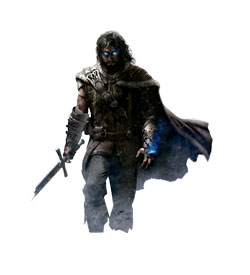Licensed games are typically, to put it delicately, awful. More often than not they’re simple cash-ins, next to nothing is spent developing them, and, in the case of Lord of the Rings properties, the publisher knows that the picture of Gandalf on the cover will make back any expenses several times over. Thankfully, Middle Earth: Shadow of Mordor is not your average licensed game. Production values, along with several unique ideas, make it a game worth playing, especially if you’re a fan of Tolkien’s The Lord of The Rings.
Middle Earth: Shadow of Mordor is a non-canonical entry set in between The Hobbit and The Fellowship of the Ring. The Dark Lord Sauron is slowly waking and gaining power, and Mordor is being overrun by orcs called ‘uruks.’ There are two player-controlled protagonists, a former ranger captain of Gondor cursed with undeath (Talion) and an elf-wraith (who is actually an important character within The Lord of the Rings, having a special relationship with the One Ring). These two actually play as one character, Talion, for unlike the wraith, he has physical form. The wraith provides a number of unique abilities for Talion to use, such as teleportation, a wraith bow, mind control, and enhanced senses.
The two set out to use Sauron’s own armies against him, and stop him from returning to Middle Earth with his former strength. This quest brings them into conflict with the uruk of Mordor.
In terms of gameplay, Middle Earth: Shadow of Mordor should be immediately familiar to anyone who’s played a title from the Batman: Arkham series or Assassins Creed. Shadow of Mordor surpasses the last Batman game I played (Batman: Arkham City). One of the game systems that allows it to do this is the nemesis system.
The nemesis system allows for additional depth among enemy leaders by displaying their strengths and weaknesses, overall power, standing within the uruks, etc. As one would expect, there are unlimited numbers of uruk grunts, none of whom should pose a problem to Talion.
There are three tiers of captains, and they serve as a sort of field leader of the uruks. You will find them scattered amongst the grunts; they can be easily detected with your wraith vision. However, if you don’t rely on wraith vision, you’ll be in for quite a few surprises. Some of these encounters may be pleasant, in which you receive experience points and a rune that can be used to enhance weapons. Other battles can involve enemy captains getting promoted and gaining strength, like in one instance when I lost a battle to my nemesis, who I later hunted down for the boosted reward.
You might run into captains while you cross the map, or perhaps in a side-mission. Encounters like these make Shadow of Mordor a much more unique and enjoyable experience. The relationships among captains are also worth mentioning for being both dynamic and complex. There are all sorts of power struggles amongst them: hunts for beasts, executions of other captains, clashes between captains, and others. As Talion, you can interfere in these clashes for your own gain.
The next tier of the nemesis systems is occupied by the warchiefs, and these encounters are on a tier of their own. At different parts of the game, you may need to either brand the warchiefs so that you can control them, or simply assassinate them. Warchiefs aren’t roaming around the map like captains, so if you want to face one you will have to complete a mission inside their stronghold to lure them out. Once they come out, they will be followed by their bodyguards, unless you assassinated the bodyguards earlier.
Even if you do wind up having to fight a warchief and several captains, there is still a chance of success. The environment in Shadow of Mordor is excellent, and filled with weapons one can potentially use against the uruks. The well-executed mounted combat system could also potentially give one an edge.
However, the easiest way to take out a warchief is to brand his bodyguards, thus telling a bodyguard to betray his warchief. This creates a mission where the warchief is lured out, and your follower stabs him in the back, starting the warchief off at a disadvantage. If you are successful, either the warchief will die and your branded uruk will succeed him, or you will manage to brand the warchief during the battle, which will result in no officer deaths.
Another aspect of Shadow of Mordor that sets it apart from other similar titles is how it told its story, specifically how dark it got in doing so. More often than not, I thought the plot was very well done, although it only lasted me about 12 hours total. Also, the nemesis system stops working at the end. Once all the uruk officers have been branded, there’s pretty much nothing to do. However, for a game like this, one wouldn’t expect a postgame, or a particularly long story anyway (it’s much more cinematic and short-lived, like a move in some regards). Considering how much depth was offered by the nemesis system while it lasted, I was more than satisfied.
The voice-acting was outstanding, and Gollum’s in particular was done so well that I thought the actor was Andy Serkis, who voiced Gollum in the movies.
The music was mostly good, being an orchestral score similar to what one would hear in the movies; although there could have been a few more tracks, and one or two of them sounded a little goofy.
Some have criticized Shadow of Mordor for its ending, but I’m divided on the matter. In terms of overall content, I thought the ending was outstanding (the best I’ve seen in a long time). However, the execution seemed to be lacking (they did in 8 minutes what should have taken a half-hour, and it didn’t contain nearly enough gameplay). That said, while Shadow of Mordor isn’t quite as precious as the One Ring, it’s set for a sequel, and after playing it, I want one. In terms of score, I think Shadow of Mordor deserves a 9/10.
IMAGE TAKEN from shadowofmordor.wikia.com




